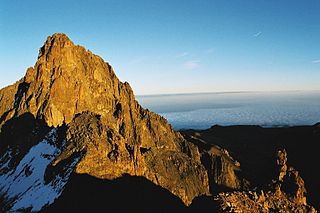
Mount Kenya is an extinct volcano in Kenya and the second-highest peak in Africa, after Kilimanjaro. The highest peaks of the mountain are Batian, Nelion and Point Lenana. Mount Kenya is located in the former Eastern and Central provinces of Kenya; its peak is now the intersection of Meru, Embu, Kirinyaga, Nyeri and Tharaka Nithi counties, about 16.5 kilometres south of the equator, around 150 km (90 mi) north-northeast of the capital Nairobi. Mount Kenya is the source of the name of the Republic of Kenya.

Henry Salt was an English artist, traveller, collector of antiquities, diplomat, and Egyptologist.
The East African mountains are a mountain region in the African Great Lakes, within Kenya, Uganda, Tanzania, Democratic Republic of the Congo, Rwanda and Burundi.

The Eastern Arc Mountains are a chain of mountains found in Kenya and Tanzania. The chain runs from northeast to southwest, with the Taita Hills being in Kenya and the other ranges being in Tanzania. They are delimited on the southwest by the fault complex represented by the Makambako Gap that separates them from the Kipengere Range. To the northeast, they are delimited by more recent volcanism represented by Mount Kilimanjaro. The chain is considered a tentative World Heritage Site.
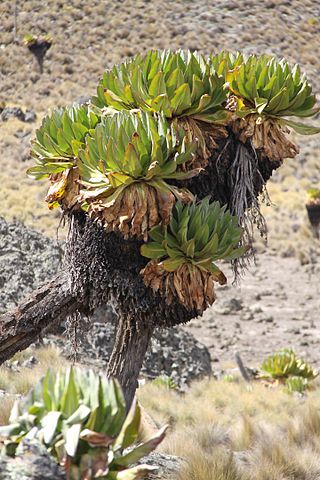
Dendrosenecio keniodendron or giant groundsel is a species of the genus Dendrosenecio of the large family Asteraceae and is one of the several species of giant groundsels endemic to the high altitudes of the Afrotropics, including Dendrosenecio johnstonii (Senecio battiscombei) occurring on Mount Kilimanjaro, Mount Kenya, and the Aberdare Mountains, Dendrosenecio keniensis occurring the lower alpine zone of Mount Kenya and D. keniodendron occurring in higher and drier sites on Mount Kenya. The giant rosette plants, sometimes 6 metres (20 ft) tall, often grow in even-sized stands, with different understory communities under different-aged stands.

The moorland chat, also known as the alpine chat or hill chat, is a species of songbird in the Old World flycatcher family. It is endemic to north-east Africa where it is common in its habitat. It lives at high altitudes on moors and grassland, usually above 3,400 m (11,100 ft), but can live as low as 2,100 m (6,900 ft). It has a short tail and long legs. It is bold and will approach people.
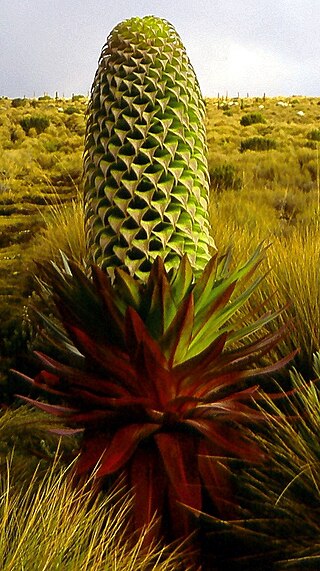
Lobelia deckenii is a species of flowering plant in the family Campanulaceae. It is a giant lobelia endemic to the mountains of Tanzania. It is listed as a threatened plant of the forests of Cherangani hills, Kenya. It grows in moist areas, such as valley bottoms and moorland, in contrast to Lobelia telekii which grows in a similar but drier habitat. These two species produce occasional hybrids. Lobelia deckenii plants usually produce multiple rosettes. Each rosette grows for several decades, produces a single large inflorescence and hundreds of thousands of seeds, then dies. Because individual plants have multiple rosettes, they survive to reproduce repeatedly, and plants with more rosettes flower more frequently. It is iteroparous.

The afroalpine vlei rat is a species of rodent in the family Muridae. It is found in the high moorlands of Kenya.

Amietia wittei is a species of frog in the family Pyxicephalidae. It is found in Kenya and Tanzania, including Mount Elgon in the Kenya/Uganda border region. Its type locality is in Molo, Kenya, located near the top of the Mau Escarpment. The specific name wittei honours Gaston-François de Witte, a Belgian naturalist.
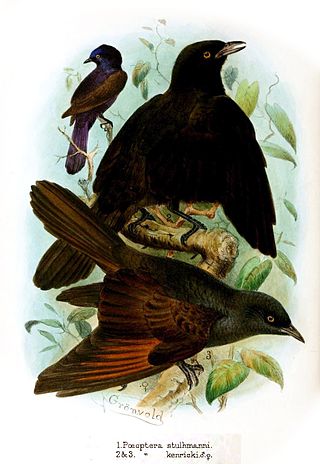
Kenrick's starling is a species of starling in the family Sturnidae. It is found in Kenya and Tanzania.

Ctenochromis pectoralis, the Pangani haplo, is a species of fish in the family Cichlidae. It was originally characterized in the Pangani River of Tanzania, and may also be present in Kenya. It is listed as extinct by IUCN as a result of a 1996 evaluation, but this appears to be incorrect. A more recent IUCN publication stated that this species is not endangered in any way.

Dendrosenecio is a genus of flowering plants in the sunflower family. It is a segregate of Senecio, in which it formed the subgenus Dendrosenecio. Its members, the giant groundsels, are native to the higher altitude zones of ten mountain groups in equatorial East Africa, where they form a conspicuous element of the flora.
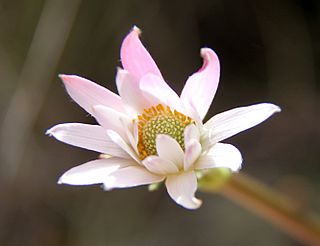
Anemone thomsonii is a species of flowering plant in the buttercup family Ranunculaceae. It is a low to high (7–70 cm) geophyte with finely divided leaves from the ground, and a stem that carries one flower, which has about twenty sepals, that are white or light pink inside and mostly have a very wide purple stripe at the outside. The species is limited to the highlands of East Africa.
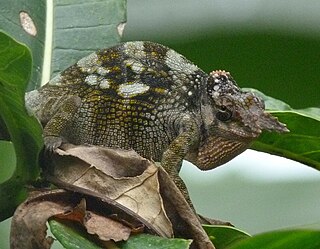
Kinyongia tavetana, the Kilimanjaro two-horned chameleon or Kilimanjaro blade-horned chameleon, is a species of chameleon in the genus Kinyongia. It is native to forests, woodlands, well-wooded gardens and plantations in the highlands of southern Kenya and northern Tanzania. Its type locality is Mount Kilimanjaro, but it is also known from Chyulu Hills and Mount Meru to the Pare Mountains.

Haplosciadium is a monotypic genus of flowering plants in the family Apiaceae (Umbelliferae). Its only species is Haplosciadium abyssinicum. It is a flat rosette plant endemic to the Afro-alpine zones on East African mountains, occurring on moist valley bottoms above 3,500 metres (11,500 ft). It engages in geocarpy as an adaptation to living on frost-heaved soils.
Lieutenant-Colonel Thomas Herbert Elliot Jackson was an English coffee farmer in Kenya. He served as an officer in the British Army during the Second World War, seeing service with the King's African Rifles and as a military administrator in British Somaliland. Jackson served in the Kenyan colonial administration during the Mau Mau Rebellion.
William T. Stanley was an American mammalogist who was a manager of the collections at one of the world's largest natural history museums and a student of the mammals of eastern Africa. He was an evolutionary biologist and mammalogist, and at the time of his death was the director of the Field Museum of Natural History's Collections Center and the Collection Manager of the Field Museum's Collection of Mammals. Stanley studied the biogeography, ecology, evolution, and systematics of shrews, bats and rodents that live on mountains within Tanzania and surrounding countries.
George Salt was an English entomologist and ecologist. He was elected a Fellow of the Royal Society in 1956.
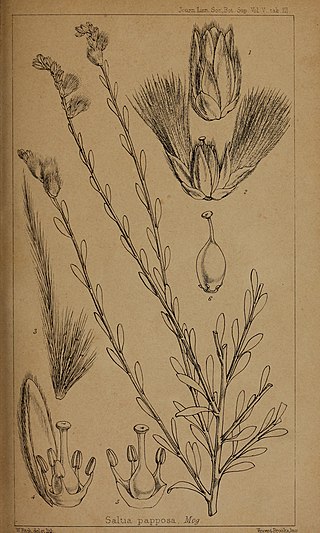
Saltia is a monotypic genus of flowering plants belonging to the family Amaranthaceae. It just contains one species, Saltia papposa. It is in the Amaranthoideae subfamily.
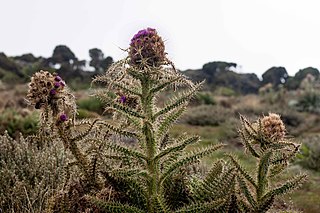
Afrocarduus is a genus of flowering plants in the sunflower family, Asteraceae. It includes ten species of thistles native to the mountains of tropical Africa, ranging from Nigeria to Ethiopia and Zimbabwe.















